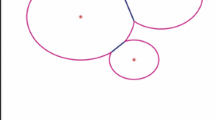Abstract
To tackle the problem of simultaneous localization and mapping (SLAM) in dynamic environments, a novel algorithm using landscape theory of aggregation is presented. By exploiting the coherent explanation how actors form alignments in a game provided by the landscape theory of aggregation, the algorithm is able to explicitly deal with the ever-changing relationship between the static objects and the moving objects without any prior models of the moving objects. The effectiveness of the method has been validated by experiments in two representative dynamic environments: the campus road and the urban road.
Similar content being viewed by others
References
DURRANT-WHYTE H, BAILEY T. Simultaneous localization and mapping: Part I [J]. IEEE Robotics & Automation Magazine, 2006, 13(2): 99–110.
SMITH R C, CHEESEMAN P. On the representation and estimation of spatial uncertainty [J]. International Journal of Robotics Research, 1986, 5(4): 56–68.
CHEN Bai-fan, CAI Zi-xing, HU De-wen. Approach of simultaneous localization and mapping based on local maps for robot [J]. Journal of Central South University of Technology, 2006, 13(6): 713–716.
LI Yang-ming, LI Shuai, GE Yun-jian. A biologically inspired solution to simultaneous localization and consistent mapping in dynamic environment [J]. Neurocomputing, 2013, (104): 170–179.
PETROVSKAYA A, THRUN S. Model based vehicle detection and tracking for autonomous urban driving [J]. Autonomous Robots, 2009, 26(2/3): 123–139.
MONTEMERLO M, THRUN S, WHITTAKER W. Conditional particle filters for simultaneous mobile robot localization and people-tracking [C]// IEEE International Conference on Robotics and Automation, ICRA. 2002. Wachington DC: IEEE, 2002: 695–701.
HÄHNEL D, SCHULZ D, BURGARD W. Mobile robot mapping in populated environment [J]. Advanced Robotics, 2003, 17(7): 579–597.
WANG C C, THORPE C, THRUN S. Online simultaneous localization and mapping with detection and tracking of moving objects: Theory and results from a ground vehicle in crowded urhan areas [C]// IEEE International Conference on Robotics & Automation, ICRA. Taipei: IEEE, 2003(1): 842–849.
WANG C C. Simultaneous localization, mapping and moving object tracking [J]. International Journal of Robotics Research, 2007, 26(9): 889–916.
HUANG G Q, RAD A B, WONG Y K. A new solution to map dynamic indoor environment [J]. International Journal of Advanced Robotic Systems, 2006, 3(3): 199–210.
MEYER-DELIUS D, BEINHOFER M, BURGARD W. Occupancy grid models for robot mapping in changing environment [C]// Proc of the AAAI Conf on Artificial Intelligence. Toronto, Ontario: AAAI, 2012: 2024–2030.
TIPALDI G D, MEYER-DELIUS D, BEINHOFER M, BURGARD W. Lifelong localization and dynamic map estimation in changing environment [C]// RSS Workshop on Robots in Clutter. Berlin: RSS, 2012: 80–81.
TIPALDI G D. LifeNav-reliable lifelong navigation for mobile robots [EB/OL]. [2015-10-21]. http://www.lifelong-navigation.eu/.
TIPALDI G D, MEYER-DELIUS D, BURGARD W. Lifelong localization in changing environment [J]. International Journal of Robotics Research, 2013, 32(14): 1662–1678.
MAZURAN M, BURGARD W, TIPALDI G D. Nonlinear factor recovery for long-term SLAM [J]. International Journal of Robotics Research, 2016, 35(1): 50–72.
AXELROD R, BENNETT D S. A landscape theory of aggregation [J]. British Journal of Political Science, 1993, 23(23): 211–233.
AXELROD R M. The complexity of cooperation: Agent-based models of competition and collaboration [M]. Princeton, New Jersey: Princeton University Press, 1997.
AXELROD R, MITCHELL W, THOMAS R E, SCOTT BENNETT D, BRUDERER E. Coalition formation in standard-setting alliances [J]. Management Science, 1995, 41(9): 1493–1508.
SUGANUMA S, HUYNH V N, NAKAMORI Y, WANG S. A fuzzy set based approach to generalized landscape theory of aggregation [J]. New Generation Computing, 2005, 23(1): 57–66.
Author information
Authors and Affiliations
Corresponding author
Additional information
Foundation item: Project(XK100070532) supported by Beijing Education Committee Cooperation Building Foundation, China
Rights and permissions
About this article
Cite this article
Hua, Ch., Dou, Lh., Fang, H. et al. A novel algorithm for SLAM in dynamic environments using landscape theory of aggregation. J. Cent. South Univ. 23, 2587–2594 (2016). https://doi.org/10.1007/s11771-016-3320-9
Received:
Accepted:
Published:
Issue Date:
DOI: https://doi.org/10.1007/s11771-016-3320-9




